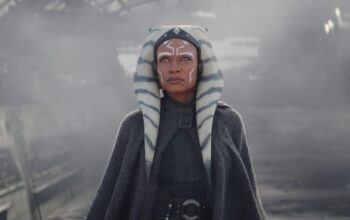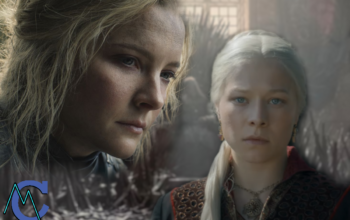You’re reading part 2 of our Historical Epic series.
Read part 1 here!
The filming techniques and writing that was prevalent in Braveheart and Gladiator help make Fantasy possible on the big screen. This cinematic formula reached its zenith when the Lord of the Rings trilogy hit theaters in 2001-2003. While Lord of the Rings is far from historical, there are elements from history that seep into it. Obviously, it is a medieval-esque world but with actual wizards and mystical creatures. Aragon is clearly a William Wallace type character as he serves the role of reluctant hero who fell into his leadership. As the films get bigger so too do their battles and how these projects borrowed from films like Braveheart in how to depict you characters and armies.
As a holdover from the classic films from the 1950s-70s, these large-scale productions tend to develop a 3-4 run time. As well as that these films are accompanied by a massive score with choirs singing an expertly crafted made up language (Tolkien was first and foremost a linguist). Furthermore, the LOTR films shows what you can do by combining the effects of CGI. Sets and extras are expensive so it makes sense to use them in larger shots where a few hundred extras can look like thousands. However, it is important that when it’s up close an actual props and people to make you feel like you are in that time period/setting. The entire city of Minas Tirith was created through a combination of CGI and model work and we get in my opinion one of the coolest castles ever.
As the Fantasy genre changed so did the blending of History and myth. With the success of LOTR, filmmakers sought the opportunity to capitalize on the Fantasy genre. One of those elements is to experiment with old mythological stories in an attempt to blend history and fiction together.
De-Mystifying Legends
One such example of demystifying the legends was 2004’s Troy. Directed by Wolfgang Peterson, Troy borrows much of the same elements from other films, a large cast including Brad Pitt, Eric Bana, and Peter O’Toole. Like LOTR, it blends practical sets with superimposed armies made to look bigger than they really are. One crucial aspect to this film however was the absence of the gods. The intention behind this is that the filmmakers want something that is closer to real life. We don’t relate to gods debating who side to empower as much as Hector knowing he has everything to lose if he dies. This means that the gods are not there to help the Greeks or Trojans like in the original poem. Instead, the gods have more of an omnipresence. Characters like King Priam and the priestess Braces have strong belief that the gods favor the vulnerable. In contrast to the Greeks like Agamemnon believe the gods back theirs down to the fact that Achilles is a seemingly divine warrior prodigy.
Even legendary events were changed to fit a real setting. For example, it was Achilles’ heel that became his downfall as his mother dunked him into a magical spring to make him invulnerable to blades. Only his heel wasn’t touched which was why Paris’s arrow was able to kill him. The movie makes no mention of that event and instead has Achilles simply be super skilled. When Achilles’ heel gives way, it’s not a poison arrow that kills him but rather more arrows that hit him in his chest that he pulls it out. Conveniently, he dies right before the other Greeks found his body with the arrow still in his heel, clearly intending to give birth to a legend.
Re-Contextualizing King Arthur
Troy was not the only film that tried to put realism in a legend. A similar attempt was made in the same year with King Arthur. Directed by Antoine Fuqua and starring Clive Owen in the titular role, this movie attempts to integrate actual history into the story. Instead of Arthur being a Native Briton, he is a Sumerian drafted into the roman army as a child in forced servitude. Years later Arthur is now a roman commander who’s approaching the end of his 25-year servitude. Furthermore, it takes place at a time when the Romans were withdrawing from Britain leaving the Island vulnerable to migrating Saxon tribes.
According to The Anglo-Saxon Chronicles, there was a clash between the Romano Britons and the invading Saxons around 500AD known as the Battle of Badon for which that battle halted Saxon expansion. They were led by a commander named Ambrosius Aurelianus to whom some believe is the historical inspiration for Arthur. The filmmakers also try to reflect one this too aesthetically, we see Hadrian’s wall along the Scottish border, and even Arthur and his companions are dressed to resemble a Roman commander and not the medieval knight in plate armor that won’t exist for another 800 years.
It’s clear that there were attempts to re-imagine the historical context behind Arthur, however that’s not the idea most people come into when watching these movies. This may be the reason why historical revisions such as this don’t not get enough attention. People come into these films wanting to see King Arthur fight dragons, Merlin summoning magic, and Morgan plotting revenge on his brother. When you take away the mystical element in some ways it strips these legends of their Divinity and legend.
Conclusion
Re imagining classic myths to give them a more historically accurate makeover certainly has ambition. However, there’s great risk in taking away the mythos. It’s like the controversy of the 1988 film, The Last Temptation of Christ and how it taps around the idea that Jesus is someone who resisted getting himself crucified, gets into arguments with God, and almost takes the chance to live another life. In many aspects it Makes him more human, but that’s not what other people are looking for, and thus you have a divided audience. And a divided audience often spells gloom for a film’s success.
Continue reading – part 3 is here!






One thought on “Fantasy and De-Mystifying Legends”
Comments are closed.